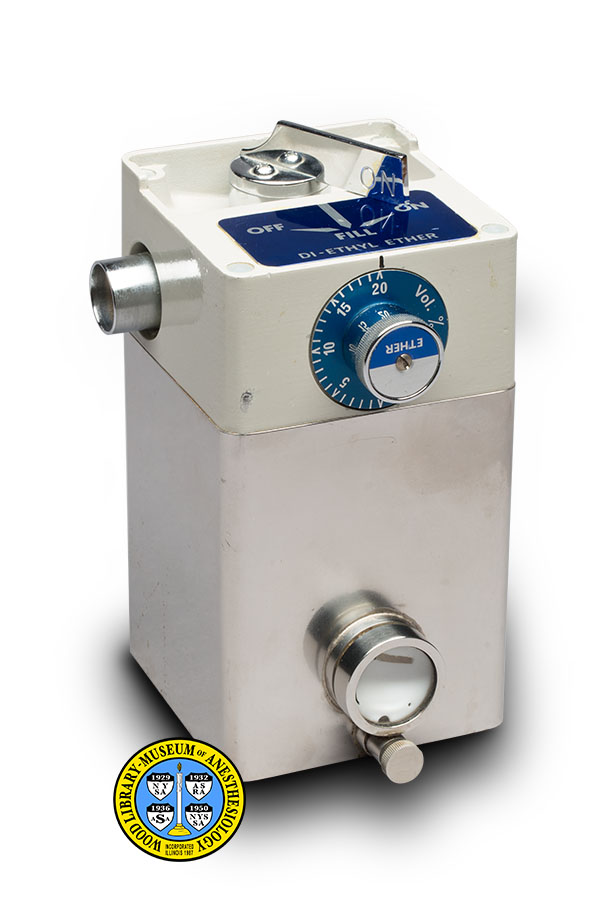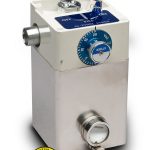Penlon Abingdon Vaporizer
Abingdon Vaporizer
Mechanical vaporizers convert liquid anesthetics to vapor for inhalation anesthesia. These vapors are added to the gases flowing through the anesthesia machine. The Abingdon Vaporizer was made by Longworth Scientific Instruments Co., Ltd. Founded in Oxford, England in 1943, the company had strong ties to the University of Oxford's Nuffield Division of Anaesthetics. By 1953, the company had moved to the nearby town of Abingdon, and by 1972, Longworth had changed its name to Penlon.
British inventors Basil R. Sugg and John Lloyd applied for a U. S. patent for their vaporizer in 1966. The patent was granted in 1969 and was assigned to Longworth. The example shown here closely resembles that illustrated in the patent. By 1970, Longworth was marketing a more streamlined model. In that model, the on-off handle was no longer recessed, and a filling port had been added which was similar to those of competitors' vaporizers. In 1975, the vaporizer was redesigned again. Originally calibrated for ether, later models were calibrated for halothane, trichloroethylene, methoxyflurane and enflurane.
Catalog Record: Penlon Abingdon Vaporizer Abingdon Vaporizer
Access Key: aqkl
Accession No.: 1995-03-31-1 C
Title: [Abingdon vaporizer] / Longworth Scientific Instruments Co., Ltd.
Corporate Author: Longworth Scientific Instruments Co., Ltd.
Publisher: Abingdon, Oxfordshire, England : Longworth Scientific Inst. Co., Ltd.., [between 1966 and 1970].
Subject: Anesthesia, Inhalation – instrumentation.
Subject: Ether, Ethyl.
Subject: Vaporizers.
Note Type: General
Notes: The first year in the date range is based on the filing date of the U. S. patent application. The object may have been manufactured earlier. The second year in the date range is based on the date of the earliest description of the succeeding model found by the cataloger.
Described from the perspective of the user, with the controls facing forward.
Note Type: Citation
Notes: Harris Calorific Company file. Archives. Located at: Wood Library-Museum of Anesthesiology, Schaumburg, Illinois.
Note Type: Citation
Notes: Howard R. Abingdon vaporisers – a preliminary report. J Royal Naval Medical Service. 1983;69:104-106.
Note Type: Citation
Notes: Jephcott A. A History of Longworth Scientific Instrument Co. Ltd. London: Regency Press, 1988:149.
Note Type: Citation
Notes: Longworth Scientific Instrument Co., Ltd. Abingdon Vaporizers. Longworth Scientific Instrument Co., Ltd., October, 1970. In: Penlon Company File. Archives. Located at: Wood Library-Museum, Schaumburg, IL.
Note Type: Citation
Notes: Penlon, Ltd. Abingdon Vaporizers. Abingdon, Oxfordshire, England: Penlon, Ltd., August, 1975. In: Penlon Company File. Archives. Located at: Wood Library-Museum, Schaumburg, IL.
Note Type: Citation
Notes: Sugg BR, Lloyd J, inventors; Longworth Scientific Instrument Co., Ltd., assignee. Anaesthetics administering apparatus. US patent 3,438,372. April 15, 1969.
Note Type: Physical Description
Notes: One vaporizer; The upper third of the walls of the apparatus are made of a dull gray metal, and the lower two thirds are clad in a bright metal (aluminum?); The top of the unit is divided into two unequal portions; The front portion has a label that reads, from left to right: “OFF FILL ON [new line] DI-ETHYL ETHER”; The rear portion is hollowed out to a depth of approximately 2 centimeters below the front portion; This concave depression appears to serve as the fill port for the vaporizer; A metal (chrome?) control lever is seated in the center of this reservoir; A backstop prevents this lever from turning more than 180 degrees; The side of the lever that is seen when the lever is turned fully to the right is marked “ON”; the opposite side of the lever, seen when it is turned fully to the left, is marked “OFF”;
On the front side, in the upper third, there is a control dial marked: “5, 10, 15, 20 [new line] Vol. % ETHER”; The knob on this dial is marked “ETHER”; In the lower third of this side there is a window for the purpose of observing the level of the liquid contents; This window is occupied by a white plastic insert; Directly below this window there is a drainage tube with a screw cap; A threaded extender on the underside of this tube has been broken off short;
Two connectors extend from the upper third of the unit; These are placed directly opposite to one another; Both extend approximately 1.5 centimeters from the respective walls of the unit; The connector that extends from the left wall is approximately 2 centimeters in diameter; The connector that extends from the right wall is approximately 2.5 centimeters in diameter;
A bracket is affixed by screws to the back of the upper portion; A label plate on this bracket reads: “ABINGDON VAPORIZER [new line] Patent Pending U. K. Reg. Design No. 924233 [new line] Made in England by [new line] LONGWORTH SCIENTIFIC [new line] INST. Co. Ltd. [new line] Abingdon”; A second label plate below this reads: “Supplied by [new line] HARRIS CALORIFIC Co. [new line] Cleveland, Ohio”; The back of the apparatus is etched, near the bottom left corner: “SERIAL NO. [new line] 97-3”; The only feature on the base is a screw in the right rear corner.
Note Type: Reproduction
Notes: Photographed by Mr. Steve Donisch, June 19, 2017.
Note Type: Acquisition
Notes: Gift of Mrs. Roderick K. Calverley.
Note Type: Historical
Notes: Mechanical vaporizers convert liquid anesthetics to gaseous form. These vapors are added to the flow of gases administered for inhalation anesthesia. The cataloged object was made by Longworth Scientific Instruments. Founded in 1943 to make the Macintosh Laryngoscope, Longworth had strong ties to the University of Oxford’s Nuffield Department of Anaesthetics. By 1953, the company had moved from Oxford to the nearby town of Abingdon. By 1962 Longworth had acquired another Oxford manufacturer, Pentland Instrument Co., Ltd., and adopted the “Penlon” trademark. The company continued to be known as Longworth through the 1960s, but by 1972 it had changed its name to Penlon. The company was acquired by InterMed, Inc. in 1975, when it became known as Penlon, Ltd. It became an independent company again in 1996.
In his history of the Longworth Instruments company, Jephcott states that the Abingdon Vaporizer had been developed by 1968 (page 149). In 1966, British inventors Basil Raymond Sugg and John Lloyd applied to patent the vaporizer in the United States. The U. S. patent was granted in 1969, and was assigned to Longworth. The cataloged object closely resembles that illustrated in the U. S. patent. By 1970, Longworth was marketing a more streamlined model of the Abingdon Vaporizer. In that model, the on-off handle was no longer recessed, and the filling port had been changed to one which was similar to that used on the TEC series of vaporizers made by Longworth’s competitor, Cyprane. In 1975, the vaporizer was redesigned and marketed under the company’s new name, Penlon, Ltd. In that model, the on-off handle was eliminated. Originally calibrated for ether, later models were calibrated for halothane, trichloroethylene, methoxyflurane, and enflurane.
The cataloged object is marked “Patent Pending”, and was distributed in the United States by the Harris Calorific Company of Cleveland, Ohio. Harris also distributed products of the British manufacturers, Blease, Portex, and British Oxygen Co.
Note Type: Exhibition
Notes: Selected for the WLM website.


